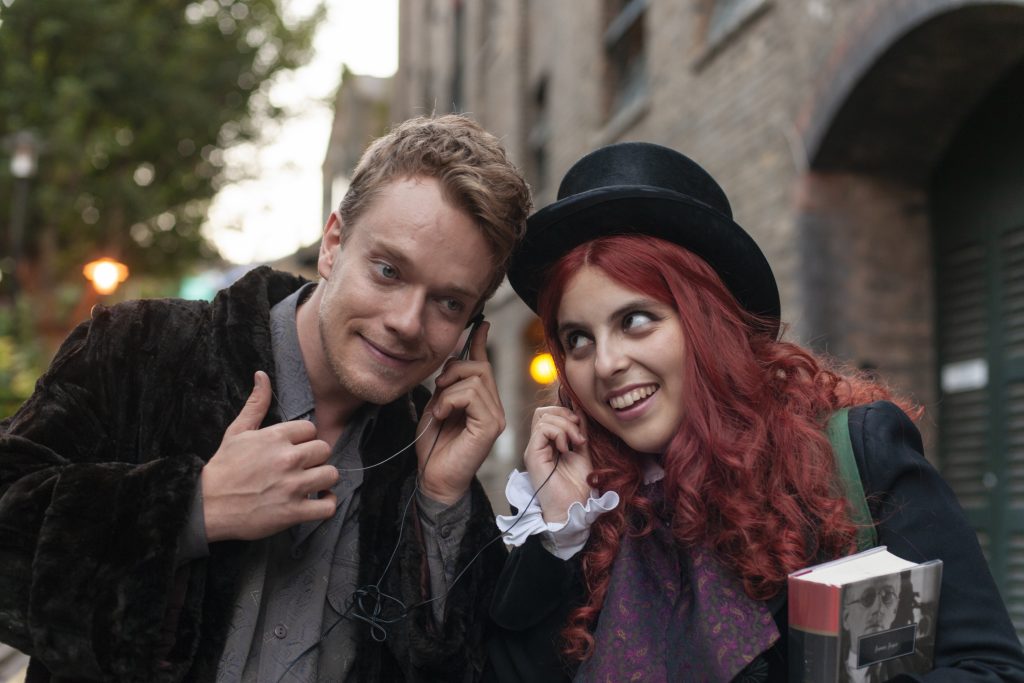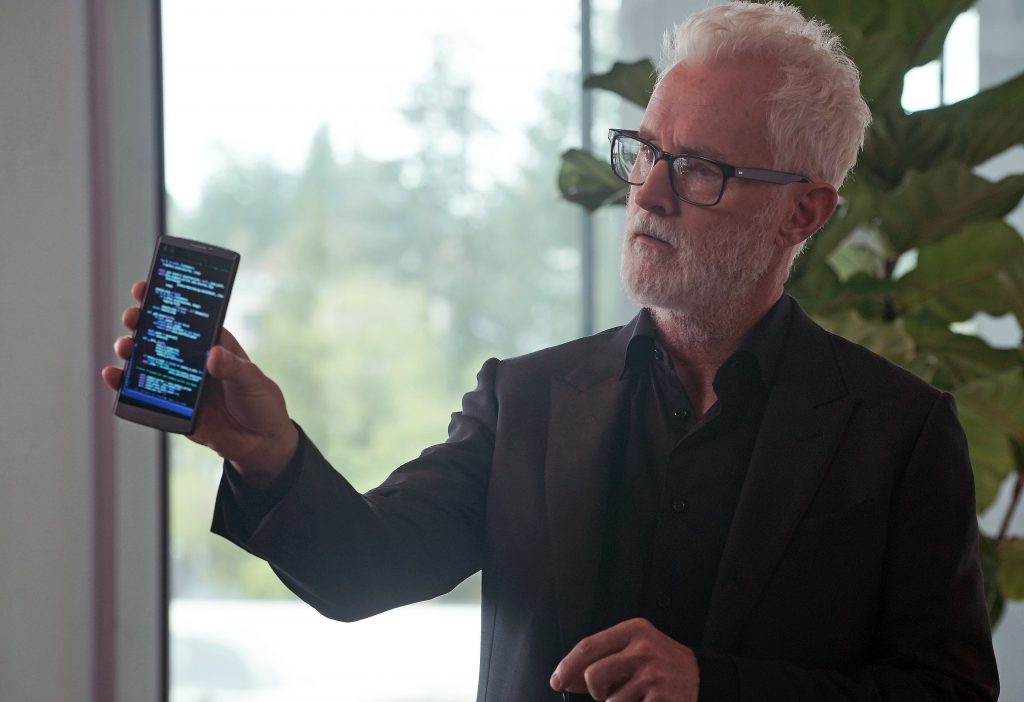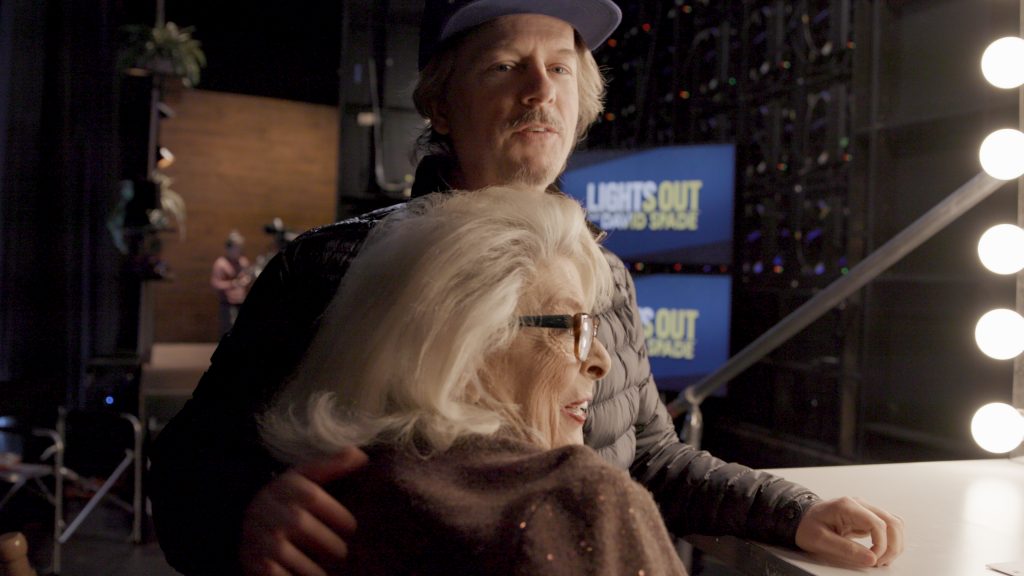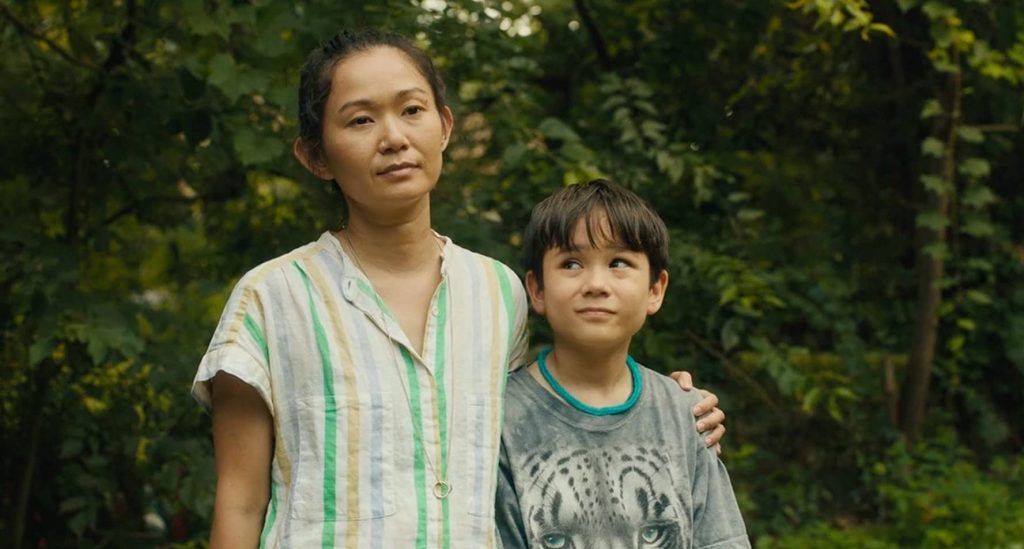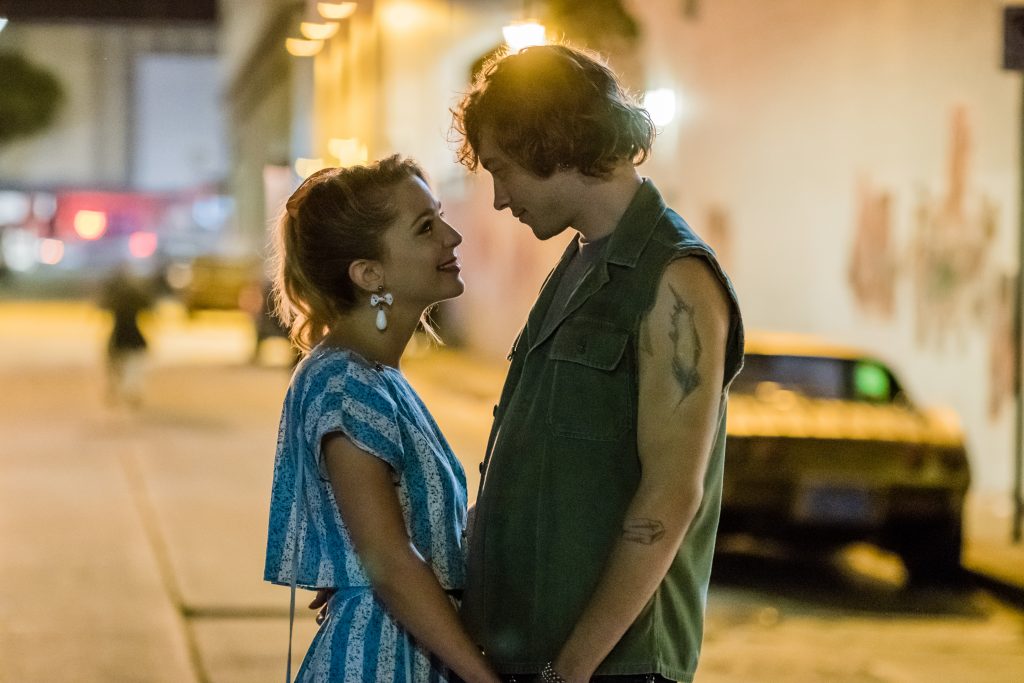May 13, 2020
by Carla Hay

Directed by Tyler Spindel
Culture Representation: Taking place in Hawaii and Portland, Oregon, “The Wrong Missy” is a comedy with a predominantly white cast (with a few Asians, Latinos and African Americans) representing the middle-class and wealthy.
Culture Clash: A lovelorn, middle-aged bank executive mistakenly invites a “blind date from hell” to be his companion at a corporate retreat.
Culture Audience: “The Wrong Missy” will appeal mostly to people who like very raunchy comedies and David Spade.
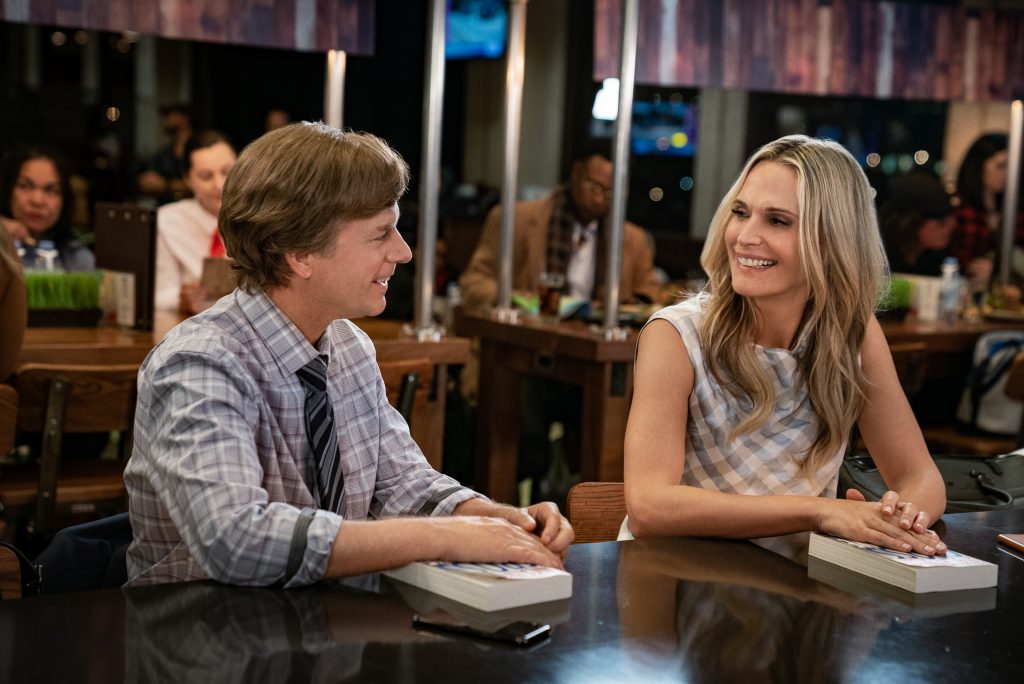
Adam Sandler’s Happy Madison Productions has been making comedy films for Netflix for the past several years, with varying levels of quality—from mediocre to terrible. “The Wrong Missy” falls on the mediocre end of the scale, and maybe it’s because Sandler isn’t a star or writer of the movie.
Except for 2019’s award-winning drama “Uncut Gems,” Sandler hasn’t been a good movie in decades. Still, there are signs that Sandler’s influence is all over “The Wrong Missy,” since the movie has plenty of jokes and gags about vomiting and other bodily functions. And several of Sandler’s relatives (his wife Jackie Sandler; his wife’s brother Chris Titone; and his nephew Jared Sandler) all have roles in the film, as do frequent Sandler collaborators David Spade, Nick Swardson and Rob Schneider.
In “The Wrong Missy,” Spade stars as bank executive Tim Morris, who is nursing a broken heart after his ex-fiancée cheated on him. Tim (who lives and works in Portland, Oregon) has reluctantly gotten back in the dating pool again. In the beginning of the film, he’s going to a restaurant/bar to meet a blind date in person.
His date texts him that she’s at the bar wearing a blue dress, but that a “meathead” is giving her a lot of rude and unwanted attention. She asks Tim to help her get away from this jerk. Tim sees that there’s only one woman (played by Candace Smith) wearing a blue dress at the bar, and she’s sitting next to a tall and muscular guy (played by Joe “Roman Reigns” Anoai), who strongly resembles actor Jason Momoa.
When Tim tries to get the woman (who’s pregnant) to leave the bar and sit with Tim at his table, the guy tells Tim to get lost because the woman is with him. Tim insists that the woman leave with him, and the man gets up and threatens to fight Tim and have management get involved. Not wanting to make a scene, Tim backs off and sits at his table, confused over what just happened.
Just then, his blind date Melissa, who goes by the name Missy (played by Lauren Lapkus), shows up at the table and admits that she played a prank on Tim and that he passed with flying colors. She tells Tim that she usually plays this prank on blind dates she’s meeting for the first time, as a test to see how far they would go to get in a fight for her.
It’s clear from Missy’s loud, over-the-top and pushy demeanor that she has no social graces and is very unaware of how embarrassing her behavior is. The date goes from bad to worse, when Missy keeps badgering Tim about him being a teetotaler, as she seems fully intent on getting drunk. Missy then gets belligerent with the couple at the bar, which causes Tim to feel even more humiliated.
Tim makes an excuse to go to the men’s restroom, but as he tries to escape through the window, Missy unexpectedly surprises him by coming out from underneath one of the bathroom stalls. (How she got there so quickly is one of those “only in a movie” situations that require a certain suspension of disbelief.) Tim is too nice to hurt her feelings and reveal that he was trying to escape from the date, but he privately vows never to see Missy again.
While he’s in an airport to go on a business trip, Tim and a beautiful blonde (played by Molly Sims) accidentally bump into each other. As he’s about to board his plane, Tim realizes that he accidentally has the woman’s carry-on bag, which is identical to his. He sees from the name tag that the woman’s name is Melissa Doherty.
As Tim frantically looks for her, he sees her in the waiting area, and they give each other their bags back with a lot of relief. Tim and Melissa strike up a conversation at the bar, since they’ve both missed their flights. During their conversation, they find out they have a lot of things in common: They’re both teetotalers, they both like the same types of music, and they’re both even reading the same book (James Patterson’s “Cross the Line”), which they have tucked in their carry-on bags.
Their attraction to each other leads them to have a spontaneous makeout session in a janitor’s closet at the airport. But their intimate encounter is interrupted because Melissa’s flight is boarding, so they quickly exchange numbers and promise to keep in touch with each other. For the first time in a long time, Tim think he’s might have found true love. During their texting sessions, Tim also finds out that she has a sexually adventurous side because she immediately asks him to send photos of his penis, which he does to comical results.
Meanwhile, back at his job, the bank that Tim works for (the fictional Credit of America) is going through some major changes. A merger has resulted in an abrasive and arrogant new CEO named Jack Winstone (played by Geoff Pierson) taking over, and he’s looking for a new president of the company. Tim’s nosy co-worker pal Nate (played by Nick Swardson), who works in the bank’s human resources department, tells Tim that he’s on the short list to be promoted to president. Tim’s biggest competition is co-worker Jess (played by Jackie Sandler), who’s nicknamed “The Barracuda” because she has a reputation for being ruthless.
Tim tells Nate about his memorable airport encounter with Melissa and how they’ve been “dating” by phone texting until they can see each other in person again. They look her up on the Internet and find out that she was a star student-athlete at Georgetown University (where she graduated summa cum laude in 2002) and that she was Miss Maryland in 2009. Nate encourages Tim to invite Melissa to the company’s upcoming corporate retreat in Hawaii.
Tim is very reluctant to make this offer, since he thinks the relationship is too new for this type of invitation. But Tim eventually changes his mind, and his invitation is eagerly accepted. Nate arranges for Melissa to be on the trip, by booking her on the plane seat next to Tim and making sure that she’s booked to stay in Tim’s hotel suite.
But when Tim is on the plane for the trip, he sees to his horror that “the wrong Missy” is the one who got the invitation. Somehow, Tim made the dumb mistake of texting “the wrong Missy” the entire time. And now he’s stuck with the Missy who was the “date from hell” for the entire trip. She tricks Tim into taking an animal tranquilizer by literally shoving it in his mouth.
She’s also very horny and not afraid to show it, since Tim wakes up to Missy sexually fondling him with her hand underneath a blanket. Missy later uses a similar tactic to have sexual intercourse with Tim, when he wakes up to find her on top of him in bed. It says a lot about the double standards in society when a woman sexually assaulting a man in this way is used as comedy in a movie, whereas if the genders were reversed, there would be a lot of public outcry and controversy over this content.
Although “The Wrong Missy” has a lot of bawdy predictability, what makes this film stand out from other Sandler-produced comedies is the gleefully unhinged performance of Lapkus, who could pass for a taller, brasher younger sister of Kristen Schaal. Missy is such a train wreck, especially when she’s drunk and stoned, that much of the film is about Tim being humiliated by her antics and trying to clean up messes that Missy makes. Missy is also a non-stop talker—at one point in the movie, Tim calls her a “blabalanche,” as in a combination of a blabbermouth and an avalanche.
And wouldn’t you know, Tim’s ex-fiancée Julia (played by Sarah Chalke) works for the company too, so she’s also on this corporate retreat. Tim and Missy have an awkward meeting in the hotel lobby with Julia and her good-looking but conceited new man Rich (played by Chris Witaske), who also works for the company. Rich is the guy whom Julia cheated with when she was engaged to Tim, and the infidelity led to Tim and Julia breaking up.
Before the trip, Tim had been bragging to his co-workers about Missy’s beauty and accomplishments. But now that he’s stuck with “the wrong Missy,” much of the movie is about Tim trying to convince his co-workers that the Missy who’s with him is the same Missy he told them about, because his pride won’t let him admit that he made a dumb mistake in this identity mix-up.
Schneider has a supporting role as a reckless boat captain named Komante, a loopy burnout who encounters the group when his boat is charted by the company for an outing in the ocean. Head honcho Jack, who wants to prove to his employees that he’s a tough alpha male, insists on going in the water for shark sighting. And, predictably, he insists that a reluctant and frightened Tim go with him. Missy doesn’t help matters, because she berates Tim into going shark sighting with his boss, thereby further embarrassing Tim in front of his co-workers. There are some very slapstick moments in this scene that involves chum and vomit, further establishing Missy as a walking nightmare.
There’s also a somewhat silly subplot where Missy has skills as a hypnotist, which she uses on Jack to improve his marriage and change how he perceives Tim and Jess. This subplot is intended to show that as crazy-acting as Missy is, deep down she has a heart of gold, is a lot more emotionally intelligent than she first appears to be, and she really does care about true love.
Some of the gags in the movie work pretty well for some genuinely funny moments, such as the opening “blind date” scene and another physically comedic scene involving a sexual threesome with Tim, Missy and another woman on the retreat. (This review won’t reveal the spoiler info about who the other woman is.) Meanwhile, other scenes don’t work at all, such as a scene with the employees participating in a talent show during the retreat and a scene with a hypnotized Jack thinking that he’s a mermaid and insisting on interviewing Tim (who’s also dressed as a mermaid) and Jess in the ocean.
And what about the Missy whom Tim think is his Ms. Right? Tim tries to frantically get her to come to the retreat anyway, but she says she can’t because of work obligations. When she does show up toward the end of the movie, the results are very predictable.
And there’s a random cameo from Vanilla Ice. It’s a scene that will probably be funniest to people in Vanilla Ice’s and Adam Sandler’s generation (Generation X), who remember when Vanilla Ice went from being the hottest rap star in pop music to being a laughingstock has-been when he was exposed for lying about having a “street cred” background.
Spade doesn’t really do anything new in this movie that he hasn’t done already in several other films, since he often plays the “horrified straight man” to a wacky comedic partner. “The Wrong Missy” screenplay by Chris Pappas and Kevin Barnett also won’t be a considered a classic in the subgenre of raunchy romantic comedies. The movie has its best moments mostly because of the eye-catching and memorable talent of Lapkus, who seems to have above-average improv skills. “The Wrong Missy” can definitely be considered a breakout movie role that could lead to better things for her.
Netflix premiered “The Wrong Missy” on May 13, 2020.




